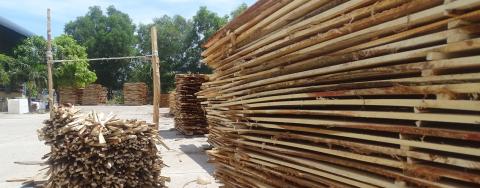FSC remains sole forest scheme for LEED Green Building
Should the forestry benchmark of LEED - the US rating system for green building – be changed, permitting non-FSC schemes to earn green building credits? This question has been buzzing in the forestry and green construction communities for years. Now it’s decided: architects, developers and construction companies still need to specify FSC to gain LEED timber credit.
A ballot carried out among the members of the US Green Building Council (USGBC) in December rejected a proposal to introduce a new forestry benchmark under the US LEED green building standard.
The proposal might have opened the door for the other major forestry scheme in the US, the PEFC-endorsed SFI.
Proposed new benchmark controversial
During the past decade, the LEED program has specifically required FSC certification for obtaining green credits for the timber used in construction. Meanwhile other forestry schemes have emerged and grown, and the fixed preference for FSC in LEED has stirred increasing debate.
Supporters of SFI have therefore called for a more inclusive process, permitting other schemes to earn LEED credits. This reasoning led to a proposal for a new forestry benchmark with a set of criteria that would allow all schemes passing the criteria to earn LEED timber credit.
However, the proposed certified wood credit proved too controversial. According to an open letter submitted to the USGBC by a number of NGOs including the Rainforest Alliance, the proposed benchmark was too weak to spur positive change in the forest industry.
Need for credible timber credits
The decision to keep the forestry bar at its existing high level and continue to require FSC certification only was welcomed by many environmental organizations inside and outside the US, who did not see the proposed forestry benchmark as a credible baseline for responsible forestry.
For example, six leading Canadian environmental NGOs applauded the USGBC "for doing the right thing for North America's forests". Large volumes of Canadian timber are exported and used on the US construction market. Inside the US, not only green NGOs but also leading architects and designers had warned the USGBC against lowering the forestry benchmark.
“I believe it was a wise decision. The final version of the proposed benchmark represented a step backward for USGBC in promoting responsible forestry. The business world is very clearly embracing a higher level of environmental and social responsibility, and sustainability certification programs like LEED are highly dependent on stringent requirements and control for their credibility and long-term survival”, comments David Bubser, US Regional Manager of the Rainforest Alliance's SmartWood Program.
Mr. Bubser continues: “At the Rainforest Alliance, we do support the concept of using a benchmark framework focused on meaningful thresholds. It is crucial for the green credibility of the timber credits that the benchmark criteria provide a reasonable baseline for sustainable forestry. Unfortunately, the dilution of requirements relating to important criteria made the final proposal unacceptable. With its rejection of a weak forestry benchmark, the USGBC has shown the leadership and integrity that has worked with great success to date”.
LEED (Leadership in Energy and Environmental Design) established by the US Green Building Council is a program for green building. Developed for the US market, LEED has evolved into a global trend-setter for green construction standards. Today the USGBC has more than 18,000 members, and more than 140,000 LEED Professional Credential holders.
Sources: US Green Building Council, Builder Online, FSC-US, SFI



